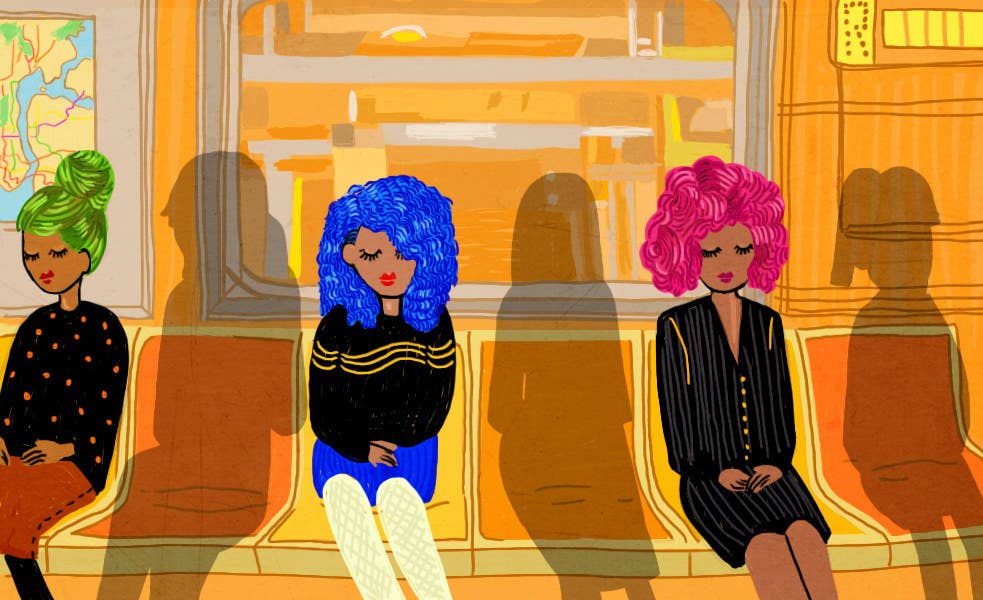
Half a year into being 25, I dyed half of my hair blue and the world shifted.
It was a lot like getting a tattoo, in that I was immediately, almost supernaturally aware of every human around me who also had dyed hair. I spent the Greenpoint leg of my morning commute appreciating the pastel dream-witch hair of former teens and felt nearly maternal toward the kids painted with a fresh coat of Manic Panic getting off the train in Clinton Hill. If I saw someone with blue hair (true blue, like mine; not teal, never teal), I felt a deep and earnest connection with them: Clearly, this was a good soul making great life choices.
Most often, the people I noticed were women of color, with dyed hair in twists or mini-dreads, or braids woven through with a contrasting hue. A lot of them were young, but plenty were older, rocking bolder shades than I could pull off.
I didn't realize it at first, but when I was noticing these women and their hair, they were noticing me, too. Part of my method for city survival is to appear aggressively unfriendly in public, so it took a few weeks of insistent taps on my shoulder for me to realize that these women were trying to talk to me: They wanted to tell me that they liked my hair.
My hair is curly and big — enough so that people feel compelled to comment on it on a daily basis. My hair is the thing I talk about with my dentist once we’ve covered the weather; it’s the way people find me across the room; it’s the reason people always remember that they’ve met me at a party.
But I was used to talking about my hair with people who (I assumed) were intrigued by my curls being kinkier and more tightly coiled than what you usually see on white people — not realizing that that’s because I’m not white people. I wasn’t used to having those conversations with people who saw my hair not as a novelty but as a desirable and feasible goal.
Until I dyed my hair, I’d never really talked about it with other women of color — that is to say, with people like me.
Those taps on the shoulder quickly turned into conversations with CVS checkout girls about what kind of dye I used, questions from teens in the library about how to keep the color vibrant and my hair healthy, a discussion with two women outside the chichi health food store by my office about whether the bleaching had changed my curl pattern (it had) and how I was dealing with that.
On my way to get a slice of pie with a friend, a teen with kinky hair swept up into a doughnut bun came up to me and blurted out, "I love your hair! Not to interrupt, but can I just ask how you got it like that?" My friend smiled at her and said, "Oh, she loves talking about her hair."
"I don't love it," I said, and promptly launched into a two-minute lecture on DIY bleaching and why you should always wash dyed hair in cold water. "You know, you're probably doing a lot of the right stuff anyway, because it's pretty similar to what you’d do with natural hair. And I’m sure it’s going to look great!”
I left the encounter smiling and only later realized why: Until I dyed my hair, I’d never really talked about it with other women of color — that is to say, with people like me.

Growing up, I was the spitting image of my dad: I have light skin, the same gray eyes, the same smile, and was already just a few inches shy of his 6’2” by the time I was 12. I inherited a lot of my mother’s features, too: We have the same freckles and the same slope to our cheekbones, the same stupid ankles that are always getting sprained.
When your ethnicity is mixed, it can be tempting to try and “sort” your features, and sometimes I would worry about how I stacked up. If I looked more like my father, did that make me white? And if my outlook on the world was more like my mother’s, did that mean I was black? The idea that this didn’t matter, that being biracial could be an identity in itself — that even the actual fact that I was biracial could supersede anyone’s notion of what that should look like, or what that meant, because I could define it for myself — well, that would take years to sort out.
I grew up in a very small town in a rural and seriously white part of the country. No joke: The 2000 census for my hometown reports that 0.13% of the 770 residents identified as African-American. If you do the math, that’s a single person: my mom. Light eyes and light skin turned out to be enough for me to read as white, and, with the exception of standardized tests, I was rarely called upon to identify otherwise.
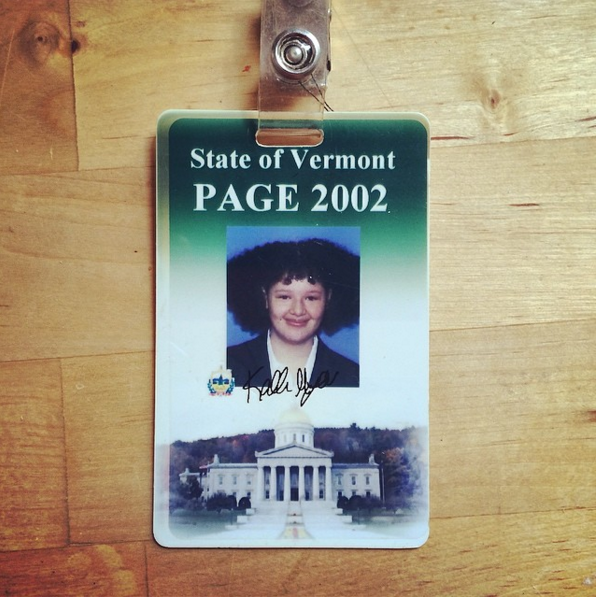
Even though I was always aware of my ethnicity, it generally felt like it only mattered to me, and by the time I entered high school I had largely disassociated from it. I regarded it as a fact about me rather than a facet of my identity, something that wasn’t really a part of me and who I was. It felt uncomfortable to claim any kind of African-American identity, largely because people seemed so surprised when I told them about it. If no one around me could see it, maybe it wasn’t really there.
When I got accepted to colleges and realized that one of my scholarships was specifically for “scholars of color,” I marked it as a both a pro (“scholarship”) and a con (“for nonwhite kids”) when I was trying to decide what school to pick. When my future alma mater sent me the invitation to a pre-orientation week specifically for students of color, I filed it in the recycling bin: “Of color” didn’t mean me, not then.

The correct term for my hair, if I’m looking for Tumblr inspiration, is “natural.” This seems so obvious to me now that it's almost stupid to point out. But there were years and years — formative, tender, pre-Solange years — when I truly believed that hairstyling ideas from Sarah Jessica Parker might work for me, when I washed my hair daily and then shellacked it in Herbal Essences mousse, when I paid top dollar for a Ouidad “curl-enhancing” haircut that left me with ratty ends in two weeks.
And yet: During those years people told me constantly how much they loved my hair. "I'd kill for hair like yours," girls I'd just met would say, a hand already halfway to my head. "Can I just...?"
It wasn’t a compliment I took particularly well, and soon we would be cinched into a tight feedback loop, them saying they wished they could “just take your hair!” and me insisting that they should: I certainly didn’t want it.
It was better when I was young enough to believe that an interest in my hair also signaled an interest in me.
Because the truth about my hair was that it sucked: It was annoying and it bred annoyances, not the least of which was how much time I had to spend talking to people about it. In elementary school, other kids would ask if I spent all day playing with it and be genuinely surprised that I didn't. They would speculate that I didn't need a pillow at night, that they could throw anything at my head — a pencil, a brick — and it would bounce right off.
It didn’t occur to me that there was anything rude or offensive about those theories, just like it didn’t occur to me that I didn’t have to let people touch my hair. It was better when I was young enough to believe that an interest in my hair also signaled an interest in me, when it still felt like some kind of power to allow a friend to sit behind me and spend an in-class movie or a boring pre-calc lecture searching for that one mathematically perfect spiral. But more and more it started to seem like the point of my hair was to make everyone else happy, and it was just my lot in life to share this gift with the world, whether I was interested or not. Increasingly, I wasn’t.
For everyone else it was just hair, but for me it felt like much more: the most visible connection to my mother and her family, to a heritage I didn’t know how to understand. The problem with hair, of course, is that it’s rarely just about hair.

It wasn’t until I was 23 that I started to understand my hair, and to like the way it looked. I had always viewed my hair as an obstacle when it came to my personal style: If its texture wasn’t under my control, how could it ever be a part of my self-expression? Since moving to New York, my style had started evolving as I experimented with new looks and ideas, and, slowly, I began to experiment with hairstyles beyond just “up” and “down.” I practiced French braiding in front of my mirror on lazy weekend nights, learned to roll my hair up into a bouffant like Janelle Monáe, discovered the virtues of slathering my hair in coconut oil and the sheer volume — and possibility — that comes when you’re four and five days out from a wash.
The more time I took to mess around and develop styles that I liked, the less I thought of my hair as a separate entity or as something that only mattered to the people around me, and the more it felt like a part of me, and a part of how I moved through the world. The apprehension I’d often felt about my biracial identity growing up was fading as I began to see it as something that I built for myself, informed by my own experiences. And now my hair, too, was under my control, and — at long last — it looked good. Good enough, in fact, for me to pick up a Manic Panic Flash Lightning bleach kit and set about intentionally damaging it in my bathroom.
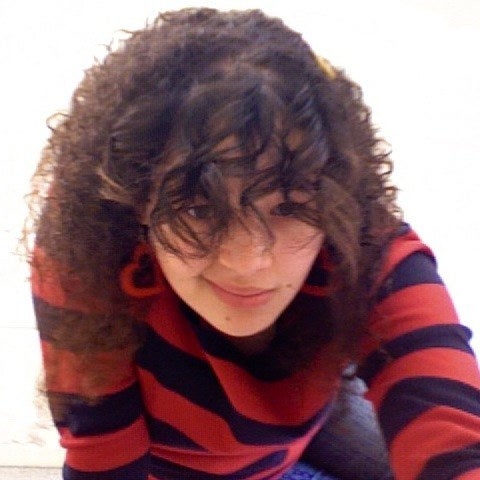
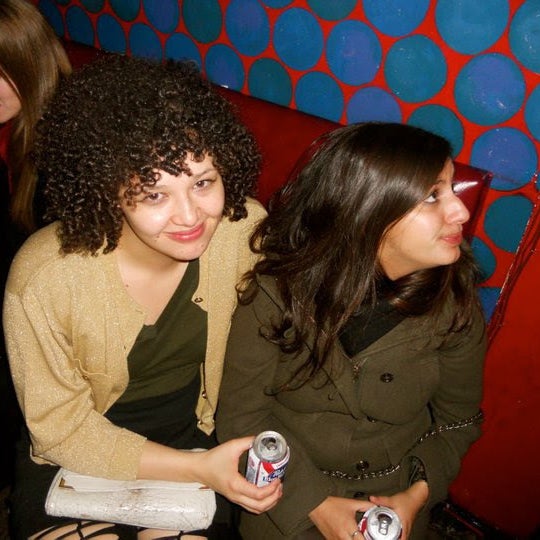
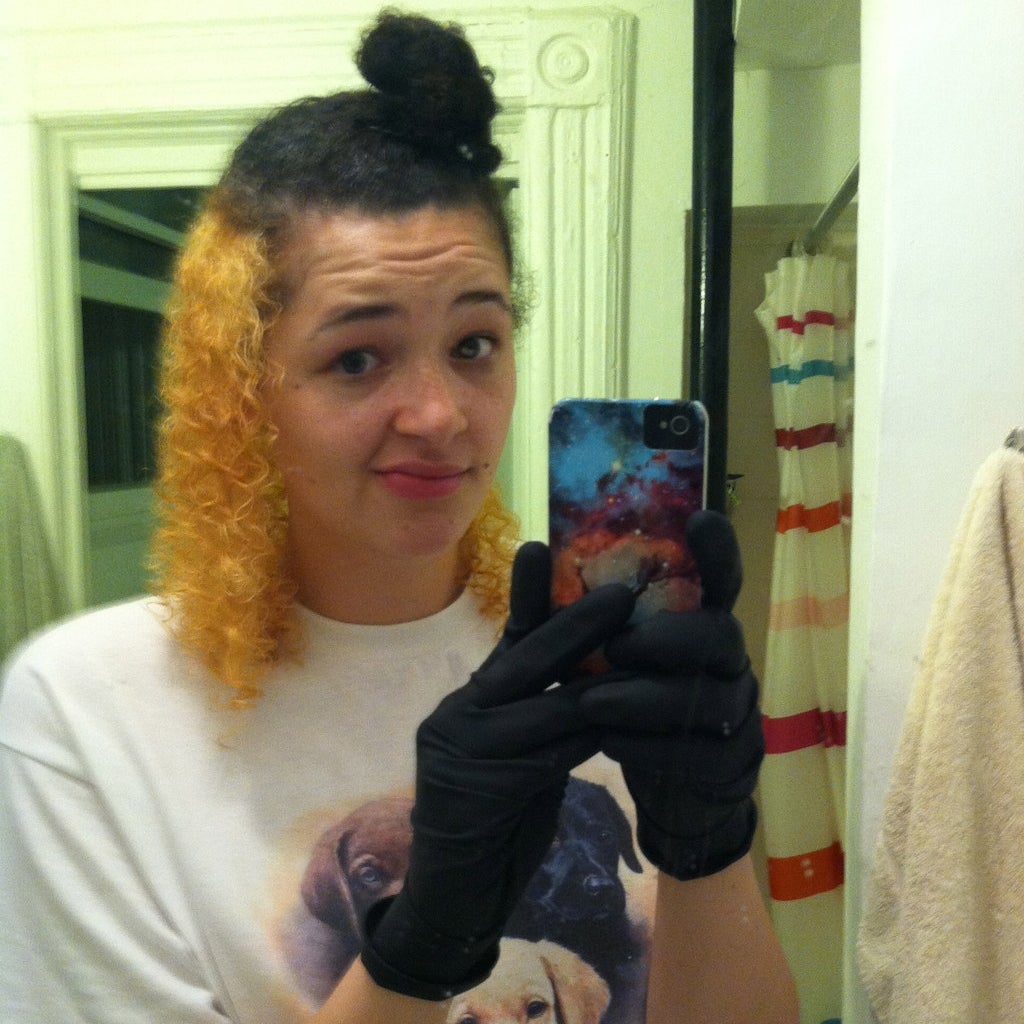
From left to right, or top to bottom: freshman year of college (2 years after a bad relaxer incident when I still had to curl my bangs because they grew in straight), just after college (before I'd really figured my hair out), and mid-bleach in the new era.
The impulse to dye my hair wasn’t new, just the conviction that it would actually look good. I’d wanted to dye it since hitting the stride of my emo years in high school, but was haunted by the fear that it would look like a clown wig. It’s not totally clear to me now if I believed that or if I just knew the boring ways that high schoolers tended to be mean (someone had already — jokingly! jokingly — tried to nickname me “Pube Head”), but it was a hard notion to shake, even through college, where I mostly left my hair alone.
Plus, my track record for drastic hair alterations was not great: I had had my hair chemically altered exactly once before, and it had been a low-grade disaster. Convinced that I would be able to love it more if I could make my hair slightly less curly (largely because I’d be able to pull off a more emo, swoopy hairstyle — the irony that Pete Wentz and his slick little bangs were biracial all along is not lost on me now), I had my mother drive me 90 minutes to the “ethnic” salon in Burlington. There, the hairdresser enlisted a man who may or may not have actually been a salon employee to help paint a lye relaxer into my hair. It was the first time I ever saw The Wiz and the first time I ever got a chemical burn. The final effect was both subtle and bad, and one that I spent the next three years growing out.
This time would be different, I told myself, and it was. It turns out that what you really need to make your hair look good is to actually try.

What I said earlier, about my world changing when I dyed my hair? It’s not really true. I’m very guilty of trying to fit my life into a narrative arc, always looking for a clear action and reaction, always wanting to write in the ending before something’s finished. In that sense, it’s very easy — very neat — to say that dyeing my hair changed the way I thought about my hair and, because of that, the way I thought about myself.
But that’s work that takes time, and it’s work that I’d been doing for years. By the time I bleached out my first test strand, I’d already started to shed the ideas I’d developed about my hair and about my identity as someone who passes among people who aren’t looking any deeper than my freckles. And I’d been doing it by treating my hair like what it was: not a vestige of something, not a hidden doorway, but my hair, a part of me and a reflection of me, an extension of myself and my style. The color has evolved, along with my style, from that deep blue to a lush jungle green, and I’ve invested fully in my hair’s health and longevity by finding a stylist (hi, Sarah!) who I can trust to keep it looking rad.
What dyeing my hair has done is allow me to change the signal, to flex a kind of control over the way people perceive me that I’m rarely allowed. Dyeing my hair doesn’t camouflage anything. Instead, it reveals much more about who I am, and, if only for the briefest moment, it forces people to deal with who I am before wondering what I am.
For some people, I have the sense that I’ve slid a little farther along the scale of ethnic ambiguity. For others, the color itself (and, I suspect, the concern over what sort of person would do that) overrides anything else that might be coded in my appearance. But for some, it offers a reflection, or a way in. However other people see me, when I look in the mirror I feel sure of one thing: I’ve never looked more myself.
